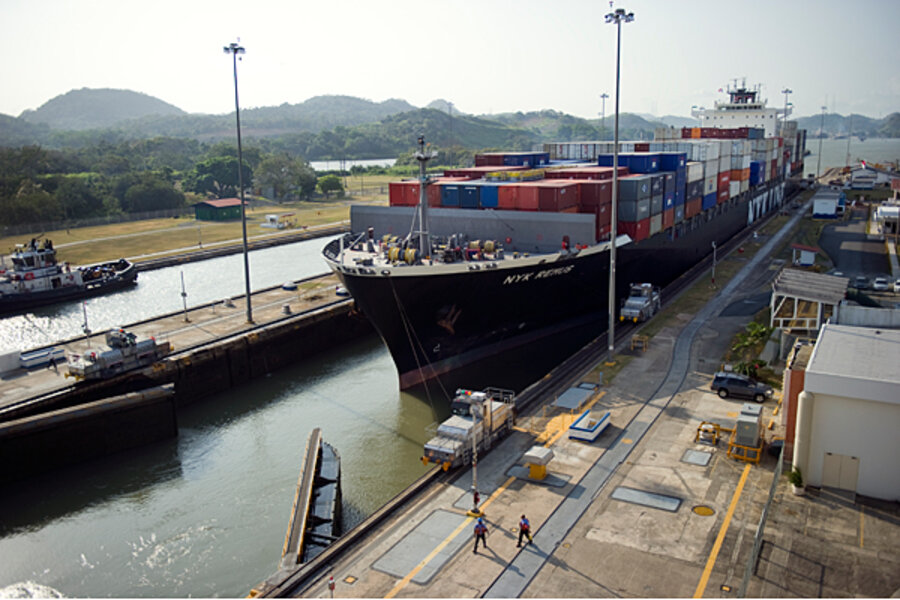Panama Canal expansion to ease international trade, with a grain of salt
Loading...
| PANAMA CITY, PANAMA
As work on the $5.25 billion Panama Canal extension project continues and the completion of the project nears, there are growing concerns about the negative environmental impact of the expansion and whether the project will deliver the economic benefits promised before construction began.
The aim of the project – expected to be completed by 2014, in time to mark the structure’s 100-year anniversary – is to double the capacity of the canal by adding two new three-chamber locks on both the Pacific and Atlantic ends. This complex upgrade will allow the world’s largest cargo ships to pass through the canal, dramatically increasing the canal’s traffic and allowing these ships access to East Coast ports.
But there are a number of potential environmental problems, the primary concern is that the expansion could contaminate Panama’s main source of drinking water, Lake Gatun, with salt water. There are also concerns that the public was not made aware of all the potential long-term impacts of the expansion project, and that its economic benefit has been overstated, according to Eric Jones, editor of the English-language Panama News.
“We didn’t really have any kind of discussion and so much of the discussion we did have was so patently fraudulent,” Jones said of the debate prior to the start of the project. “There are major concerns, but we’re not going to know how it works out until it’s done.”
Salt vs. fresh water
Each time a ship passes through the canal, salt and fresh water become mixed as the boats are raised or lowered through a series of three locks. In order for the expansion to be successful, more water must be used in the lock system, and much of this water comes from Lake Gatun, Panama’s primary fresh water supply.
There are growing concerns the water of Lake Gatun could become brackish, or have more salinity than fresh water, through this process says Charlie Andrews, a partner at the global intelligence and advisory firm Ergo who has been following the development of the canal expansion project.
“Fresh and salt water will be required to run through the channel, and this has a direct impact on Gatun Lake,” Mr. Andrews says. “There are concerns about the ability to control the amount of seawater that flows through the lake.”
Currently, the canal has the capacity to allow cargo vessels known as Panamax ships travel through. These ships have the capacity to move 5,000 twenty-foot equivalent units, similar to cargo containers carried by trains and trucks. Once the expansion is complete, post-Panamax mega-ships will be able to pass through the canal. The largest of these vessels have the ability to carry up to 13,000 cargo containers.
“When ships come up, water has to be pumped in from the sea,” says Andrews. “How do you get enough water to raise these massive ships? Both sides of the environmental fence are trying to determine, ‘How much impact will this expansion have?’” he says.
Impact downplayed
Prior to the start of the expansion, the Panama Canal Authority (ACP) conducted research to determine the overall environmental impact of the project, including an investigation into the potential to alter Lake Gatun’s salinity. All reports found that the environmental impact would be minimal, according to Daniel M. Muschett Ibarra, who works for the ACP’s Department of Engineering and Programs Administration and is overseeing the environmental aspects of the expansion.
“With our experience in the operation of that system, there is small interchange of water at the entrance of the locks to the lake,” Mr. Ibarra says. “But that salt water does not move beyond that point. We’ve been monitoring throughout the operation and there is no possibility of the lake becoming brackish.”
Ibarra says the impact of the increase in salt water is softened through the creation of three new water-saving basins. Water from these reservoirs will be used to raise and lower ships, protecting the fresh water in the canal’s watershed.
“The fresh water character of the Gatun Lake will not be changed,” he says. “We have a dedicated work force that follows through on a monthly basis to make sure we are compliant with the environmental impact study. Then we have an independent consultant that gives reports to the government.”
Global economic impact
While the environmental impact of the project is still up for debate, the economic benefit, both for Panama and the global economy, will undoubtedly be enormous. According to Ergo’s Andrews, ports along the east coast are hurrying to up their intake capacity, automate ports, and build rail facilities to move cargo containers to consumers as fast as possible.
The expansion also has the potential to increase trade between Asia and the United States. Post-Panamax ships are currently only able to unload at West Coast ports, where cargo was shipped by rail to markets in the eastern United States. After the expansion, these ships will be able to unload on the East Coast, lowering the cost of Asian goods.
The project also has an impact on Panama’s economy. The ACP claims that the canal expansion improves Panama’s long-term jobs outlook. It also will vastly increase canal revenue, the lifeblood of the Panamanian economy. Panamanian officials say the completion of the project will make Panama the strongest economy in Central America.
But Mr. Jones of Panama News said these projections, which were used to sell Panamanians on the project, are premature and unproven.
“The culture of the people that run the canals is that any obstacles to expansion can be removed,” he says.







